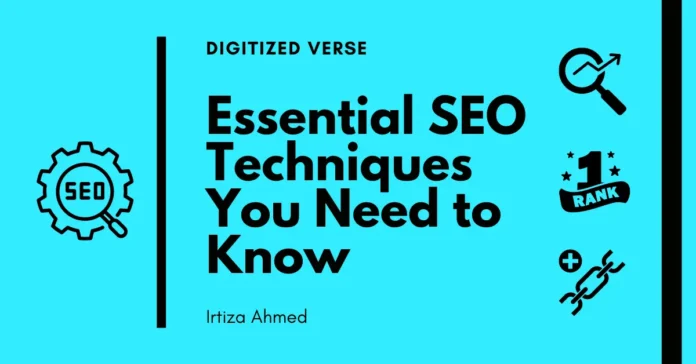Search Engine Optimization (SEO) is a term that can often feel shrouded in mystery, especially for those new to the world of digital marketing. However, understanding and implementing SEO techniques is crucial for the success of any online presence. This article, featuring life experience strategies from a Digitized Verse expert, will guide you through the essential SEO techniques, helping you move from confusion to clarity.
1. Understanding SEO: The Basics
Before diving into specific techniques, it’s important to understand what SEO is. SEO is the practice of optimizing your website to rank higher in search engine results pages (SERPs). This involves a combination of on-page and off-page strategies designed to increase the quantity and quality of traffic to your site.
2. Keyword Research: The Foundation of SEO
Keyword research is the backbone of SEO. It involves identifying the terms and phrases that potential customers are searching for related to your products or services. As I started SEO, the first and most common term I encountered was keyword research, and it remains the foundation today.
I used tools like Google Keyword Planner and SEMrush, among others. Tools like these, along with Ahrefs, can help you find the right keywords. Focus on finding a mix of short-tail and long-tail keywords to cover a broad range of search queries.
3. On-Page SEO: Optimizing Your Content
On-page SEO refers to the tactics you use directly on your website to improve its search engine rankings. This includes:
3.1 Title Tags and Meta Descriptions
Title tags and meta descriptions are crucial as they provide the first impression of your website in the SERPs. Make sure your title tags are clear, include your primary keyword, and are between 50-60 characters. Meta descriptions should be compelling and around 150-160 characters.
3.2 Header Tags
Header tags (H1, H2, H3, etc.) help structure your content and make it easier for search engines to understand. Your H1 tag should include your primary keyword and clearly state the topic of the page. Use H2 and H3 tags to organize subtopics and related points.
3.3 Quality Content
Content is king in SEO. Ensure your content is original, informative, and engaging. Aim for a minimum of 1000 words for blog posts, but adjust based on the complexity of the topic. Use keywords naturally and avoid keyword stuffing, which can harm your rankings.
3.4 Image Optimization
Images can enhance user experience but also affect your site’s load time. Use descriptive file names and alt tags with relevant keywords. Compress images to improve loading times without compromising quality.
4. Technical SEO: The Backbone of a Healthy Website
Technical SEO ensures that search engines can crawl and index your site efficiently. Key areas to focus on include: (and sometimes, you’ll need a developer for this part—trust me, it can be a bit tricky in your early days!)
4.1 Mobile-Friendliness
With mobile traffic surpassing desktop, mobile-friendliness is crucial. Use responsive design to ensure your site looks good and functions well on all devices. Google’s Mobile-Friendly Test can help you check your site’s compatibility.
4.2 Site Speed
Site speed is a significant ranking factor. Use tools like Google PageSpeed Insights to identify areas for improvement. Compress images, leverage browser caching, and minimize JavaScript to speed up your site.
4.3 XML Sitemaps
An XML sitemap helps search engines understand the structure of your website. Ensure your sitemap is up-to-date and submitted to Google Search Console.
4.4 Secure Sockets Layer (SSL)
An SSL certificate encrypts data between your website and visitors, enhancing security. Google prefers secure sites, so make sure your site uses HTTPS.
5. Off-Page SEO: Building Authority and Trust
Off-page SEO involves activities conducted outside your website to improve its ranking. This includes:
5.1 Backlinks
Backlinks are links from other websites to yours. High-quality backlinks from authoritative sites signal to search engines that your site is trustworthy. Focus on earning backlinks through guest blogging, creating shareable content, and building relationships with influencers in your niche.
5.2 Social Media
Social media marketing can drive traffic to your site and indirectly influence your SEO. Share your content on platforms where your audience is active. Engage with followers and participate in conversations to boost your online presence.
5.3 Local SEO
For businesses targeting a local audience, local SEO is essential. Optimize your Google My Business listing, gather positive reviews, and ensure your name, address, and phone number (NAP) are consistent across all online directories.
Remember, it’s one of the most time-consuming parts of SEO, but don’t lose your focus. Monitor your Domain Rating (DR) and Domain Authority (DA) to gauge the effectiveness of your strategy and track your progress.
6. User Experience (UX): The User-Centric Approach
User experience (UX) is becoming increasingly important for SEO. A positive UX can lead to higher engagement rates, lower bounce rates, and better rankings. And always try to see the page as if you are a visitor. Would that page be powerful enough to make you stick around? When optimizing for UX, focus on:
6.1 Intuitive Navigation
Ensure your site has intuitive navigation so users can easily find what they’re looking for. Use clear menus and internal links to guide visitors through your site.
6.2 Readability
Make your content easy to read by using short paragraphs, bullet points, and clear fonts. Break up text with images and subheadings to enhance readability.
6.3 Call to Actions (CTAs)
Effective CTAs guide users toward desired actions, such as signing up for a newsletter or making a purchase. Make your CTAs clear and compelling.
7. Content Strategy: Consistency and Quality
A consistent content strategy is key to maintaining and improving your SEO. Regularly update your blog with high-quality posts, and consider incorporating other content types like videos, infographics, and podcasts. Focus on providing value to your audience and addressing their pain points. Always think about why, what answers, or benefits visitors or buyers will get from your content. It should always revolve around fulfilling your user’s needs.
8. Analytics and Reporting: Measuring Success
Analytics and reporting are essential for understanding the effectiveness of your SEO efforts. Use tools like Google Analytics and Google Search Console to track key metrics such as organic traffic, bounce rate, and keyword rankings. Regularly review your data to identify areas for improvement and adjust your strategy accordingly.
9. Staying Updated: The Ever-Changing World of SEO
SEO is not a one-time task; it’s an ongoing process. Search engines continually update their algorithms, and staying updated with the latest changes is crucial. Follow industry blogs, attend webinars, and participate in SEO forums to keep your knowledge current.
10. Common SEO Mistakes to Avoid
Even seasoned SEO professionals can make mistakes. Avoid these common pitfalls:
10.1 Keyword Stuffing
Keyword stuffing involves overloading your content with keywords in an attempt to manipulate rankings. This can lead to penalties from search engines. Instead, focus on creating natural, valuable content.
10.2 Ignoring Mobile Users
Failing to optimize for mobile can significantly harm your rankings. Ensure your site is responsive and offers a seamless experience across all devices.
10.3 Neglecting Technical SEO
Technical SEO is foundational. Don’t neglect aspects like site speed, secure connections, and proper indexing.
10.4 Poor Quality Content
Content should be high-quality and valuable to your audience. Avoid thin content and focus on in-depth, informative posts that address user needs.
Conclusion
Moving from confusion to clarity in the realm of SEO requires understanding and implementing a range of techniques. By focusing on keyword research, on-page and off-page strategies, technical SEO, user experience, and continuous learning, you can enhance your website’s visibility and drive more organic traffic. Remember, SEO is a long-term commitment, but with dedication and the right approach, the results will be well worth the effort. Embrace these essential SEO techniques and watch your online presence thrive.




